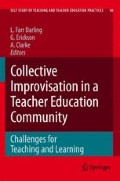Access this chapter
Tax calculation will be finalised at checkout
Purchases are for personal use only
Preview
Unable to display preview. Download preview PDF.
References
Ainsworth, S.E, Bibby, P.A. & Wood, D.J. (1997). Information technology and multiple representations: New opportunities - new problems. Journal of Information Technology for Teacher Education 6(1), 93–105.
Bruce, B.C. (1997). Literacy Technologies: What Stance Should We Take? Journal of Literacy Research 29(2), 289–309.
Bryson, M. & de Castell, S. (1998). Learning to Make a Difference: New Technologies, Gender, and In/Equity. Available: http://www.educ.sfu.ca/gentech/sshrcreport2.html.
Clift, R.T., Mullen, L., Levin, J. & Larson, A. (2001). Technologies in context: implications for teacher education. Teaching and Teacher Education 17(1), 33–50.
Council of Ministers of Education Canada. (1999). Education Indicators in Canada. See: www.cmec.ca/stats/pceip/1999/indicators/english/pages/page10e.html#Anchorpage10e.
Gore, J.M. (2001). Beyond our differences: A reassembling of what matters in teacher education. Journal of Teacher Education 52(2), 124–135.
Halliday, M.A.K. & Hasan, R. (1989). Language, Context, and Text: Aspects of a Language in a Social-Semiotic Perspective(2nd ed.). Oxford: Oxford University Press.
Haraway, D. (1991). Simians, Cyborgs and Women: The Reinvention of Nature. New York: Routledge.
Kapitzke, C. (2000). Cyber pedagogy as critical socialpractice in a teacher education program. Teaching Education 11(2), 211–229. 118
Kemmis, S & McTaggart, R. (2000). Particpatory action research. In N.K. Denzin & Y.S. Lincoln (eds.), Handbook of Qualitative Research(2nd ed.). Thousand Oaks and London: Sage Publications.
Kress, G. (1998). Visual and verbal modes of representation in electronically mediated communication: the potentials of new forms of text. In I. Snyder (ed.), Page to Screen – Taking Literacy into the Electronic Era. London and New York: Routledge.
Laferriere, T. (2000). Networked Communities of Learners: The TL * NCE Teacher Education Approach to Teacher Education Reform. Paper presented at the American Education Research Association, New Orleans, La.
Lemke, J.L. (1998). Metamedia literacy: Transforming meanings and media. In D. Reinking, M. McKenna, L. Labbo & R. Kieffer (eds.), Handbook of Literacy and Technology: Transformations in a Post-Typographical World. Mahwah, NJ: Lawrence Erlbaum Associates.
Lowrie, T. (1996). The use of visual imagery as a problem-solving tool: Classroom implementation. Journal of Mental Imagery 20(3&4), 127–140.
New London Group. (1996). A pedagogy of multiliteracies: Designing social futures. Harvard Educational Review 66(1), 60–92.
Robertson, J. (1997). Does permeation work? Promoting the use of information technology in teacher education. Journal of Information Technology for Teacher Education 6(2), 169–184.
Scardamalia, M. & Bereiter, C. (1996). Computer support for knowledge building communites. In T. Koschmann (ed.), CSCL: Theory and Practice of an Emerging Paradigm. Mahwah, NJ: Lawrence Erlbaum Associates.
Thomas, L., Larson, A., Clift, R. & Levin, J. (1996). Integrating technology in teacher education programs: Lessons from the teaching teleapprenticeship project. Action in Teacher Education 17(4), 1–8.
Tom, A. (1997). Redesigning Teacher Education. New York: State University of New York Press.
Wells, G. (1999). Dialogic Inquiry: Toward a Sociocultural Practice and Theory of Education. New York: Cambridge University Press.
Wild, M. (1996). Technology refusal: Rationalising the failure of student and beginning teachers to use computers. British Journal of Educational Technology 27(2), 134–143.
Author information
Authors and Affiliations
Editor information
Editors and Affiliations
Rights and permissions
Copyright information
© 2008 Springer Science+Business Media B.V.
About this chapter
Cite this chapter
Mitchell, J., Kelleher, H., Saundry, C. (2008). Learning By Design: A Multimedia Mathematics Project In A Teacher Education Program. In: Darling, L.F., Erickson, G., Clarke, A. (eds) Collective Improvisation in a Teacher Education Community. Self Study of Teaching and Teacher Education Practices, vol 4. Springer, Dordrecht. https://doi.org/10.1007/978-1-4020-5668-0_9
Download citation
DOI: https://doi.org/10.1007/978-1-4020-5668-0_9
Publisher Name: Springer, Dordrecht
Print ISBN: 978-1-4020-5667-3
Online ISBN: 978-1-4020-5668-0
eBook Packages: Humanities, Social Sciences and LawEducation (R0)

